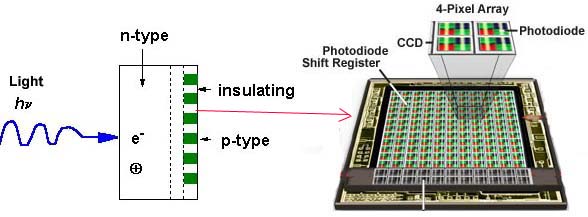|
|
Photo-Diode Array (PDA) Detectors
- Practical Electron Microscopy and Database -
- An Online Book -
|
|
https://www.globalsino.com/EM/
|
|
This book (Practical Electron Microscopy and Database) is a reference for TEM and SEM students, operators, engineers, technicians, managers, and researchers.
|
=================================================================================
A photodiode array (PDA) is a linear array of discrete photodiodes, based on photovoltaic principle, on an integrated circuit (IC) chip. Light exposure of each photodiode
generates a current. The light creates electron-hole pairs and the electrons migrate to the nearest PIN or PN junction as shown in Figure 4910. After a fixed integration time the charge at each element is sequentially read with solid-state circuitry to generate the detector response as a function of linear distance along the array. Modern PDAs are available with 512, 1024, or 2048 elements, e.g. with typical dimensions of ~ 25 µm wide and 1-2 mm high.
One advantage of PDAs is that, with numerous photoreceptors, it is placed at the image plane of a EELS and EDS spectrometer to allow a range of wavelengths to be detected simultaneously,
instead of stepping through all the wavelengths mechanically with a monochromator.

Figure 4910. Schematic of a photodiode array (PDA)
|
=================================================================================
The book author (Yougui Liao) welcomes your comments, suggestions, and corrections, please click here for submission. If you let book author know once you have cited this book, the brief information of your publication will appear on the “Times Cited” page.
|
|
